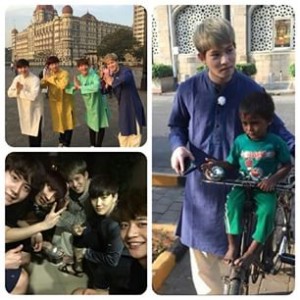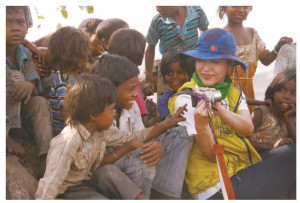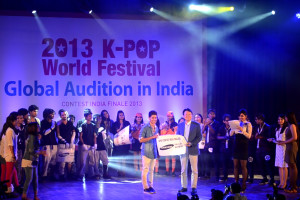 India is a nation in love with Bollywood, a film genre famous for its highly synchronised choreography, glittering outfits and unbelievably catchy tunes. You’d think that the last thing they need is more highly synchronised choreography, glittering outfits and unbelievably catchy tunes, but that is exactly what K-pop is posing to bring. It seems as if the K-pop industry has recently acknowledged India as a potentially massive market to make money in, bringing with it a range of questions on how best to approach this market, or whether to approach it at all.
India is a nation in love with Bollywood, a film genre famous for its highly synchronised choreography, glittering outfits and unbelievably catchy tunes. You’d think that the last thing they need is more highly synchronised choreography, glittering outfits and unbelievably catchy tunes, but that is exactly what K-pop is posing to bring. It seems as if the K-pop industry has recently acknowledged India as a potentially massive market to make money in, bringing with it a range of questions on how best to approach this market, or whether to approach it at all.
Fluttering India is the new variety show featuring Exo’s Suho, Super Junior’s Kyuhyun, TVXQ’s Changmin, Infinite’s Sunggyu, SHINee’s Minho and CN Blue’s Jonghyun, and raises a lot of interesting questions about K-pop’s engagement with this vastly different market. The concept behind the show is presumably one of cross-cultural interaction and the promotion of Hallyu exports to a new market. As feared by many, however, the show has demonstrated a vital lack of understanding of many parts of Indian culture. Here lies one of the greatest issues that the K-pop industry needs to acknowledge if they are to expect any degree of success in India.
 K-pop does not have a great track record with cultural sensitivity, and its success in India is hugely dependent on their ability to demonstrate cultural understanding. This involves not reducing the country to tacky tokens of curry and turbans, or approaching it with a superiority complex. This is no easy task, and it is yet to be seen whether K-pop companies value India enough as a market to put time, effort and money into appreciating the country, its 122 major languages, 36 states or union territories and the vast array of religions that its citizens subscribe to. The recent scandal in Malaysia with B1A4 shows exactly what can go wrong if there are cultural clashes, even if there was no intention of offending anyone.
K-pop does not have a great track record with cultural sensitivity, and its success in India is hugely dependent on their ability to demonstrate cultural understanding. This involves not reducing the country to tacky tokens of curry and turbans, or approaching it with a superiority complex. This is no easy task, and it is yet to be seen whether K-pop companies value India enough as a market to put time, effort and money into appreciating the country, its 122 major languages, 36 states or union territories and the vast array of religions that its citizens subscribe to. The recent scandal in Malaysia with B1A4 shows exactly what can go wrong if there are cultural clashes, even if there was no intention of offending anyone.
Fluttering India actually does demonstrate an attempt to understand India in a respectful manner. Previous depictions of India in Korean media have tended to focus on exoticising the nation, or focusing on how supposedly backward and impoverished India is. The cast of Fluttering India, on the other hand, seem to have approached India with curiosity and interest, commenting on the unique flavour of traditional Indian music and eagerly chatting to fans who approached them.
Although there are still instances of reducing India to a handful of gimmicky symbols, Fluttering India is a positive step in the right direction compared to other shows such as BoA’s Road for Hope. But although Fluttering India is a good start, the industry as a whole will need to demonstrate their sincerity towards understanding India and adapting themselves to the market.
 However, it’s worth wondering whether there even is a market in India for K-pop. If not, is it still possible for companies to create an interest among the target audience? Bollywood and Hollywood provide much of the entertainment in India, with Bollywood’s specialty being its exuberant dance routines, bold colours and ridiculously catchy songs. These are many of the things that K-pop delivers, with their own twist to it.
However, it’s worth wondering whether there even is a market in India for K-pop. If not, is it still possible for companies to create an interest among the target audience? Bollywood and Hollywood provide much of the entertainment in India, with Bollywood’s specialty being its exuberant dance routines, bold colours and ridiculously catchy songs. These are many of the things that K-pop delivers, with their own twist to it.
A plethora of reality shows are also further saturating the market, such as Indian Idol, Dance India Dance and India’s Got Talent that showcase the nation’s love of spectacles. Shows that promote artistry, fusion and live performance are also rapidly gaining popularity, such as Coke Studio @ MTV. There is a genre to suit everyone, with rock, raga rock and vedic metal being particularly popular thanks to their fusion of tradition and modern rock. With the market being so diverse and robust, K-pop faces a unique challenge to set itself apart.
 On the other hand, the fact that India celebrates stunningly synchronsied dance routines and extravagant outfits can be a bonus for K-pop companies seeking to enter the market. K-pop can appear rather in-your-face for those who are more used to solo acoustic artists than flashy dance routines, but India is likely to be receptive to K-pop. Korean dramas and Indian dramas also bear many similarities, with their wonderful melodrama, family oriented-values and plot lines of heartbreak and forbidden love.
On the other hand, the fact that India celebrates stunningly synchronsied dance routines and extravagant outfits can be a bonus for K-pop companies seeking to enter the market. K-pop can appear rather in-your-face for those who are more used to solo acoustic artists than flashy dance routines, but India is likely to be receptive to K-pop. Korean dramas and Indian dramas also bear many similarities, with their wonderful melodrama, family oriented-values and plot lines of heartbreak and forbidden love.
K-pop does bear many similarities to Bollywood, but also seems to be unique enough to captivate a new audience, with the Hallyu Wave generating growing interest in India. Puthuyugam TV, a Tamil entertainment channel based in Chennai, airs subbed Korean dramas like Boys Over Flowers and Master’s Sun. Arirang TV and KBS are also broadcast by many cable channels to eager audiences.
Interestingly, K-pop is particularly popular in Northeast India, such as in the remote states of Nagaland, Meghalaya and Manipur. The banning of Bollywood in Manipur by the Revolutionary People’s Front after a nationalistic insurgency meant that many turned to Korean entertainment to fill the void. The cultural and ethnic similarities between Koreans and those in the northeast of India made Korean entertainment easier to identify with, as many in the northeast are of Mongolian origins. Connecting with this region is vital for the K-pop industry, rather than focusing on the more populous cities of Delhi and Mumbai.
[youtube http://www.youtube.com/watch?v=tgBykbBp3rI]Several Indian cities also host an annual K-pop festival where eager fans perform covers of their favourite K-pop songs. N-Sonic became the first K-pop group to perform in India this year, after receiving a warm welcome last year when they were the guest judges for the K-pop talent competition. Unsurprisingly, 2013’s winner, Edwin Jamir, was from Nagaland.
[youtube http://www.youtube.com/watch?v=hoA8xgACWTw]The growing popularity of the K-pop festival and the Korean Culture Center’s events gives an indication that there is in fact an avid fanbase in India. Kim Kum-pyoung, the director of the Korean Culture Center, expressed his excitement at the growing fanbase in India, stating that:
On the cultural front, K-pop as a juggernaut of Korean soft-power is something we were very keen on introducing in India. With N-Sonic’s visit last year as judges of the K-pop audition, we confirmed the potential popularity of K-pop here. This concert marks the first-ever K-pop concert in the country and we have great expectations on the K-pop phenomenon taking India by storm.
The India Korea Friends Mumbai fan club estimate that there are 10,000 people from Delhi, Mumbai, Chennai and Dimapur who have joined their online fan club. IKFM have expressed their frustration at the lack of understanding of the genre, but are increasingly creating ties with Korean organisations such as the Korean consulate in India and the Korean National Museum in order to draw attention to the rapidly growing fandom. These fans can be engaged and more hype can be generated if more and more K-pop acts perform in India, as there is clearly a large fanbase that is eager to welcome their favourite idols. It’s remarkable that not once has an ‘Asian tour’ included India, when it is the second most populous country on the continent.
 This relates back to the underlying factor that will determine whether K-pop takes off in India or not: respect and recognition. K-pop is plagued by cultural insensitivity and appropriation, or notions of cultural superiority.
This relates back to the underlying factor that will determine whether K-pop takes off in India or not: respect and recognition. K-pop is plagued by cultural insensitivity and appropriation, or notions of cultural superiority.
If any K-pop company wants to break into this market, they will need to understand its complexities and ensure that they deal with the audience, the country and their Indian counterparts with respect.
Fluttering India is a positive development from previous media depictions of India, focusing on the idols’ engagement with the local culture. However, there’s still a long way to go for K-pop companies, who must make sure that they do not lose the enthusiastic yet relatively small fanbase that they already have.
(YouTube [1][2][3][4], The Hindu, New Indian Express, Korea Culture Center, KpopStarz India, DNA India, Images via KBS, News, YG Entertainment)


